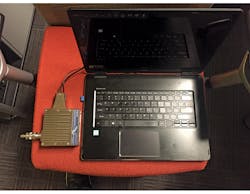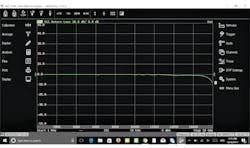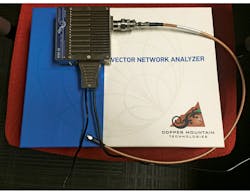Copper Mountain Technologies Takes 1-Port VNAs to the Next Level
Download this article as a .PDF
When thinking of RF/microwave test-and-measurement equipment, bulky benchtop instruments are what often come to mind. However, some manufacturers are now offering smaller, portable test instruments. One company that is known for building test instruments in small sizes is Copper Mountain Technologies, which specializes in vector network analyzers (VNAs). One of the company’s product lines currently on the market is the Cobalt series of VNAs. Copper Mountain also offers a product line of 1-port VNAs which, in its own words, delivers “lab-grade performance in a handheld device.”
The company was kind enough to loan me an R180 1-port VNA, the newest addition to the 1-port VNA product line (Fig. 1). Introduced earlier this year, the R180 covers a frequency range of 1 MHz to 18 GHz. It is well suited for both cable and antenna measurements, among other use cases. Material testing is another specific usage of note.
While the standard model is equipped with a type-N male connector, customers can also choose to purchase the R180 with a type-N female, 3.5-mm male, or 3.5-mm female connector. Furthermore, the R180 has the significant advantage of being able to connect directly to a device-under-test (DUT). Thus, a test cable is not required to perform measurements.
18-GHz VNA in Your Hand
The obvious first impression of the R180 VNA is its size, as it can essentially fit in the palm of your hand. One can easily carry the VNA from one location to another. Moreover, the R180 connects to a laptop or desktop computer via a USB cable. Once the VNA is connected to a computer, Copper Mountain’s software application enables the measurement values obtained by the VNA to be displayed on the computer screen.
The software application is very simple to download. While the company provided a USB drive that contained the software, anyone can also simply download the software from Copper Mountain’s website. Once the software is installed and the VNA is connected, operation should be relatively easy for anyone who has prior experience using a VNA.
Figure 2 shows the software application upon starting it with the VNA connected. Typical VNA functions can be seen in the figure, such as Scale, Trace, Calibration, Marker, and many others. As an example, clicking on Scale subsequently displays a number of options that users can choose, such as Scale, Auto Scale, Ref Value, and Ref Position. All of these options are obviously familiar to those who have previously used a VNA.
In addition, clicking the Trace button allows users to choose a number of data display formats, including SWR, Return Loss, Cable Loss, and Smith Chart. Distance-to-fault (DTF) measurements are also made possible by selecting either the DTF SWR or DTF Return Loss formats. In addition, Phase and Expanded Phase are two additional data display formats. In summary—and reiterating an earlier point—the software application is relatively easy to use.
The software application also allows users to save measurement values as touchstone files. Creating a touchstone file is essentially as simple as a few mouse clicks. Of course, this feature enables one to incorporate the measured values obtained from the R180 in a software simulation tool of choice.
Furthermore, anyone who has used a VNA knows how essential calibration is. Copper Mountain offers a selection of automatic calibration modules, as well as several mechanical calibration kits. For the example shown later, calibration was carried out using a 3.5-mm mechanical calibration kit with female connectors.
One additional point that should be mentioned in regard to the software application is the Demo Mode feature. Turning on the Demo Mode displays a virtual VNA measurement without an actual DUT connected to the VNA. This feature essentially allows one to explore the software and its capabilities without even needing an actual unit to test. No doubt, this feature could certainly be helpful to some users.
Simple Cable Measurement
As stated, cable measurements represent one area of use for the R180. Figure 3 shows the R180 being used to measure the loss of an 18-in. SMA cable. Figure 4 illustrates a plot of the cable’s loss from 1.5 to 2.0 GHz. It should be stated that the operating manual for the R180 contains step-by-step instructions to measure the loss of a cable such as the one shown. The example presented in the manual is a 30-m coaxial cable.
The R180 is certainly a worthy product for anyone in need of a handheld VNA to measure cables, antennas, and more. Not only can the VNA fit in one hand, the software is easy to use and offers the features needed for effective measurements. It is clear the Copper Mountain has a winning product with the R180.





